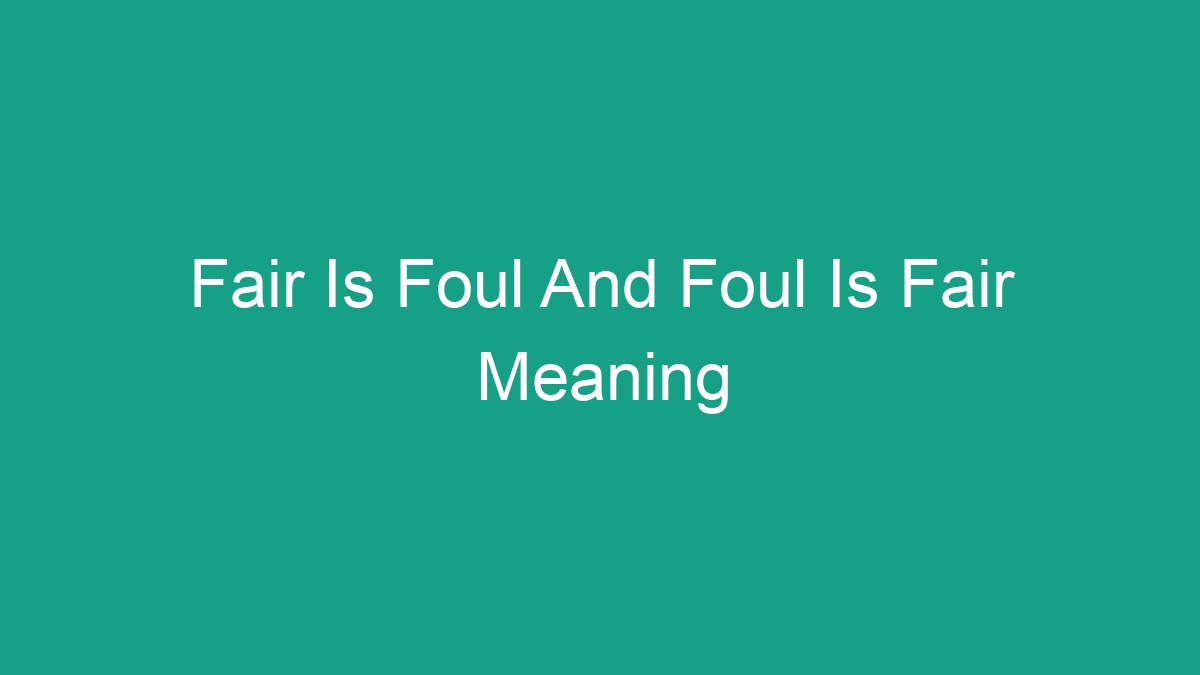
When analyzing the phrase “Fair is foul and foul is fair,” it is essential to note that it is a memorable line from William Shakespeare’s play Macbeth. This phrase carries profound meaning and has been the subject of much debate and analysis over the years. In this article, we will explore the various interpretations and significance of the quote “Fair is foul and foul is fair” in different contexts.
Interpretation of the Phrase
At its core, the phrase “Fair is foul and foul is fair” conveys the idea that things are not always what they seem. It suggests a sense of moral ambiguity and the blurring of lines between good and evil. In the context of Macbeth, this line serves as a theme throughout the play, highlighting the deceptive nature of appearances and the moral turmoil faced by the characters.
Literal and Figurative Meanings
On a literal level, the phrase can be interpreted as a reference to the distorted perception of reality. What appears to be fair and just may, in fact, be foul and corrupt, and vice versa. This idea of deception and the reversal of values is central to the themes of Macbeth.
Figuratively, “Fair is foul and foul is fair” can be applied to various aspects of life. It speaks to the complexity of human nature and the constant struggle between good and evil. In a world where appearances can be deceiving, this quote serves as a reminder to look beyond surface-level judgments and to question the true nature of things.
Analysis in the Context of Macbeth
In Macbeth, the quote “Fair is foul and foul is fair” is uttered by the three witches in the opening scene of the play. This sets the tone for the entire narrative, foreshadowing the moral confusion and duplicity that will unfold. The witches embody this idea as they manipulate Macbeth and plant the seeds of ambition and moral decay within him.
The play itself is a study of the protagonist’s descent into darkness, and the quote serves as a constant reminder of the twisted reality in which Macbeth finds himself. It reflects his internal struggle and the moral ambiguity that ultimately leads to his downfall.
Relevance in Contemporary Society
While “Fair is foul and foul is fair” originates from a 17th-century play, its relevance extends to modern times. In a world where ethical boundaries are constantly challenged, and the distinction between right and wrong is often blurred, this quote serves as a poignant reflection of societal complexities.
One can observe this ambiguity in politics, where the public is often presented with distorted truths and conflicting narratives. In the realm of social media, where reality is often curated and filtered, the quote serves as a reminder of the facade that can obscure genuine human experiences.
Philosophical and Psychological Implications
From a philosophical standpoint, “Fair is foul and foul is fair” delves into the existential question of morality and the nature of good and evil. It challenges traditional notions of righteousness and invites contemplation on the subjectivity of moral judgments.
Psychologically, the quote resonates with the concept of cognitive dissonance—the discomfort experienced when holding conflicting beliefs or attitudes. It speaks to the human tendency to rationalize and justify actions that may contradict our internal moral compass.
Interpretations in Literature and Art
Beyond Macbeth, the quote “Fair is foul and foul is fair” has inspired numerous literary works and art forms. Writers and artists have drawn on its thematic richness to explore the complexities of human behavior and the duality of existence. This quote has served as a creative wellspring for narratives that delve into moral ambiguity and the deceptive nature of appearances.
Moreover, the enduring relevance of this quote in contemporary literature and art underscores its universal appeal and timeless significance. The exploration of moral struggles and the duplicitous nature of human experience continues to captivate audiences across various mediums.
Conclusion
In conclusion, the quote “Fair is foul and foul is fair” holds profound meaning that extends beyond its original context in Macbeth. Its enduring relevance in literature, its philosophical and psychological implications, and its resonance in contemporary society all speak to its timeless significance.
As we navigate a world rife with moral ambiguity and conflicting truths, this quote serves as a poignant reminder of the intricate nature of human existence and the perpetual struggle to discern between fair and foul.
Ultimately, “Fair is foul and foul is fair” challenges us to question the validity of appearances and to delve deeper into the complexities of morality and truth.




